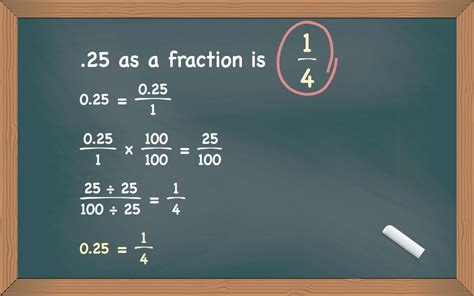What Is .25 As A Fraction
listenit
Apr 05, 2025 · 4 min read

Table of Contents
What is 0.25 as a Fraction? A Comprehensive Guide
Understanding decimal-to-fraction conversions is a fundamental skill in mathematics. This comprehensive guide will delve deep into converting the decimal 0.25 into a fraction, explaining the process thoroughly and exploring related concepts. We'll go beyond the simple conversion, examining the underlying principles and providing you with the tools to confidently tackle similar conversions in the future.
Understanding Decimals and Fractions
Before we dive into the conversion, let's refresh our understanding of decimals and fractions.
Decimals: Decimals represent parts of a whole using a base-ten system. The digits to the right of the decimal point represent tenths, hundredths, thousandths, and so on. For example, in 0.25, the '2' represents two tenths (2/10), and the '5' represents five hundredths (5/100).
Fractions: Fractions represent parts of a whole as a ratio of two numbers: the numerator (top number) and the denominator (bottom number). The denominator indicates the total number of equal parts the whole is divided into, and the numerator indicates how many of those parts are being considered.
Converting 0.25 to a Fraction: The Step-by-Step Process
The conversion of 0.25 to a fraction involves understanding the place value of the digits in the decimal.
-
Identify the place value of the last digit: In 0.25, the last digit (5) is in the hundredths place. This means the denominator of our fraction will be 100.
-
Write the decimal as a fraction: We can write 0.25 as a fraction with a denominator of 100: 25/100. The numerator is simply the digits to the right of the decimal point, treated as a whole number.
-
Simplify the fraction: To express the fraction in its simplest form, we need to find the greatest common divisor (GCD) of the numerator (25) and the denominator (100). The GCD of 25 and 100 is 25.
-
Divide both numerator and denominator by the GCD: Dividing both the numerator and denominator by 25, we get:
25 ÷ 25 = 1 100 ÷ 25 = 4
Therefore, the simplified fraction is 1/4.
Alternative Methods for Conversion
While the above method is straightforward, there are other approaches to reach the same result.
Method 2: Using the place value directly:
We can directly interpret the decimal's place value: 0.25 means 25 hundredths. This directly translates to the fraction 25/100. Simplifying as before, we arrive at 1/4.
Method 3: Understanding Equivalent Fractions:
Recognizing that 0.25 is equivalent to one quarter (1/4) can also be a useful approach. This relies on familiarity with common decimal-fraction equivalents.
Why Simplify Fractions?
Simplifying fractions is crucial for several reasons:
-
Clarity: Simplified fractions are easier to understand and work with. 25/100 is less intuitive than 1/4.
-
Consistency: Mathematics favors expressing results in the simplest possible form.
-
Efficiency: Simplified fractions make calculations more efficient.
Practice Problems: Converting Decimals to Fractions
Let's solidify our understanding with some practice problems. Try converting the following decimals to fractions:
- 0.5
- 0.75
- 0.125
- 0.375
- 0.625
Solutions:
- 0.5 = 5/10 = 1/2
- 0.75 = 75/100 = 3/4
- 0.125 = 125/1000 = 1/8
- 0.375 = 375/1000 = 3/8
- 0.625 = 625/1000 = 5/8
Converting Fractions to Decimals
It's also helpful to understand the reverse process: converting fractions to decimals. This involves dividing the numerator by the denominator. For example, to convert 1/4 to a decimal, we divide 1 by 4, which equals 0.25.
Real-World Applications of Decimal-to-Fraction Conversions
The ability to convert decimals to fractions is essential in many real-world situations:
-
Cooking and Baking: Recipes often use fractions for precise measurements.
-
Construction and Engineering: Accurate measurements are crucial in these fields.
-
Finance: Working with percentages and proportions requires understanding fractions.
-
Science: Many scientific calculations involve fractions and decimals.
Advanced Concepts: Dealing with Repeating Decimals
While 0.25 is a terminating decimal (it ends), some decimals are repeating (they continue infinitely with a repeating pattern). Converting these to fractions requires a different approach, which involves algebraic manipulation. For instance, converting 0.333... (repeating 3) to a fraction involves setting up an equation and solving for the fraction, which results in 1/3.
Conclusion: Mastering Decimal-to-Fraction Conversions
Converting decimals to fractions is a fundamental mathematical skill with widespread applications. By understanding the place value of decimals, applying the simplification process, and practicing regularly, you'll develop confidence and proficiency in tackling this essential mathematical operation. Remember, the key is to understand the underlying principles, allowing you to approach various decimal-to-fraction conversions with ease and accuracy. Through consistent practice and application, this skill will become second nature, enhancing your mathematical abilities and problem-solving skills in numerous contexts. The seemingly simple conversion of 0.25 to 1/4 opens a door to a deeper understanding of numerical representation and manipulation, preparing you for more complex mathematical challenges ahead.
Latest Posts
Latest Posts
-
Which Rock Type Is Most Likely To Contain Fossils
Apr 06, 2025
-
What Is One Way That Rna Differs From Dna
Apr 06, 2025
-
Whats The Si Unit For Force
Apr 06, 2025
-
Simple Diffusion And Facilitated Diffusion Are Related In That Both
Apr 06, 2025
-
Is Boiling Point Chemical Or Physical
Apr 06, 2025
Related Post
Thank you for visiting our website which covers about What Is .25 As A Fraction . We hope the information provided has been useful to you. Feel free to contact us if you have any questions or need further assistance. See you next time and don't miss to bookmark.
